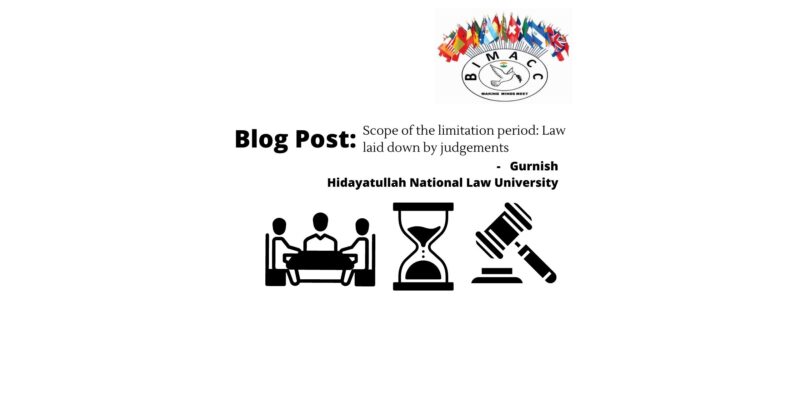
Scope of the limitation period: Law laid down by Judgements
The intent and objective of the Arbitration and Conciliation Act, 1996 is to charter out the timeous commencement of arbitration as soon as the dispute has arisen. Delay defeats justice and equity aids promptitude and resultant consequences. A defaulting party should bear the hardship and should not transmit the hardship to the other party after the claim in the cause of arbitration is deemed barred.[1] A grey area with regard to the start of the limitation period for a cause of action is analysed with the help of various judgements of the Supreme Court and the High Courts.
“Cause of action” means the whole bundle of material facts, which are necessary for the Claimant to prove the claim.[2] The cause of action becomes essential for the purposes of calculating the limitation period for bringing an action. The period of limitation for commencing an arbitration runs from the date on which the cause of arbitration accrued, that is to say, from the date when the Claimant first acquired either a right of action or a right to call for arbitration.[3] The claim is not to be brought after the expiration of a specified number of years from the date on which the cause of action accrued, so in the case of arbitrations, the claim is not to be put forward after the expiration of the specified number of years from the date when the claim accrued.[4]
Calcutta High Court has held that in respect of the determination of two different aspects, whether the claim made in arbitration is barred by limitation under the Limitation Act, 1963, and whether the claim made for section 20 of the Arbitration Act, 1940 pertaining to application to file in court, it is necessary for a valid reference that the differences must arise out of a valid arbitration agreement and must be within the time limit as stipulated in the Act. [5] Drawing a distinction between the period of limitation for filing of a claim petition and the claims being barred by time, in the case of arbitration, the limitation for the claim is to be calculated on the date on which the arbitration is deemed to have commenced.[6]
The question before the Supreme Court in the case of B and T AG v. Ministry of Defence pertained to the limitation on the claim of arbitration when the claim was raised after more than 5 years. The three principles of law with regard to the reference to arbitration in dispute of payment of wages as stated in the case[7] were – first, the right to receive payments ordinarily begins on completion of the work. Second – a dispute arises if there exists a claim and its denial/repudiation by the other party, thirdly – a person cannot postpone the accrual of the cause of action by stating that repeated letters or reminders were sent. In casu, after the dispute first arose in 2016 pertaining to wrongful imposition of liquidated damages, there was an exchange of letters which the petitioner stated served the purpose of negotiation. However, the application for an arbitrator was placed after the limitation period of 3 years. Mere correspondence of the appellant by way of writing letters/reminders to the respondent subsequent to this date would not extend the time of limitation.[8] The period of limitation for issuing a notice of arbitration would not get extended by mere exchange of letters.[9] Section 9 of the Limitation Act makes it clear that “where once the time has begun to run, no subsequent disability or inability to institute a suit or make an application stops it.”[10]
It is only after the entire history of negotiation is pleaded and placed on record that the Court would be in a position to consider such history so as to find out what was the “Breaking Point” at which any reasonable party would have abandoned efforts at arriving at a settlement and contemplated referral of the dispute for arbitration.
In order to ascertain the start of the limitation period, the breaking point is referred to. This “Breaking Point” should be treated as the date at which the cause of action arose for the purpose of limitation. The requisite amount was credited into the Government account in accordance with the instructions contained in the letter dated 11.08.2016. This was the end of the matter. To say that even thereafter, the petitioner kept negotiating with the respondent in anticipation of some amicable settlement would not save the period of limitation as the party referred to arbitration after a period of 3 years. The court laid down that if one of the parties wished to continue deliberations even before the breaking point, it would not lead to an extension of the start of the period of limitation. Therefore, in casu, the application for reference to arbitration as per Section 11 of the Arbitration and Conciliation Act, 1996 was rejected.
The position of law is crystallised through these precedents which state that pre-referral jurisdiction of the courts under Section 11(6) of the Act is very narrow, referring to the ‘Eye of the needle’ and inheres two inquiries. The first is about the existence and the validity of the arbitration agreement and the other is about the non-arbitrability of the matter concerned with the nature of the dispute. As a general rule and a principle, the arbitral tribunal is the preferred first authority to determine and decide all questions of non -arbitrability. As an exception to the rule, and rarely as a demurrer, the referral court may reject claims which are manifestly and ex-facie non-arbitrable.[11]
The High Court further suggested an amendment to fill in the gap related to section 11 of the Arbitration and Conciliation Act, 1996 to introduce a time limit honouring the objective of the Act which is to resolve disputes between the parties in a prompt manner. Due to the lack of mentioned time in the act, courts have taken recourse to the limitation period governed by Article 137 of the Limitation Act, 1963 which provides a period of three years from the day when the right to apply accrues. It is also contended that setting a time period for three years is not equitable as it leads to undue hassle for the party other than the one who had not taken action in the meanwhile.
-Gurnish
Intern
Hidayatullah National Law University
[1] B and T AG v. Ministry of Defence, 2023 SCC OnLine SC 657.
[2] Mussummat Chand Kour v. Partab Singh, ILR (1889) 16 Cal 98.
[3] West Riding of Yorkshire County Council v. Huddersfield Corpn. (1957) 1 All ER 669.
[4] Panchu Gopal Bose v. Board of Trustees for Port of Calcutta, (1993) 4 SCC 338.
[5] Jiwnani Engineering Works Pvt. Ltd. v. Union of India, AIR 1978 Cal 228.
[6] J.C. Budhraja v. Chairman, Orissa Mining Corporation Ltd., (2008) 2 SCC 444.
[7] Major (Retd.) Inder Singh Rekhi v. Delhi Development Authority, AIR 1988 SC 1887.
[8] Geo Miller and Company Private Limited v. Chairman, Rajasthan Vidyut Utpadan Nigam Limited, (2020) 14 SCC 643.
[9] S.S. Rathore v. State of M.P., (1989) 4 SCC 582.
[10] Union of India v. Har Dayal, (2010) 1 SCC 394.
[11] Vidya Drolia v. Durga Trading Corporation reported in (2021) 2 SCC 1.
Disclaimer: The views and opinions expressed in this blog are those of the author and do not necessarily reflect the official policy or position of BIMACC, any of the members of the Board, or the empanelled neutrals.
